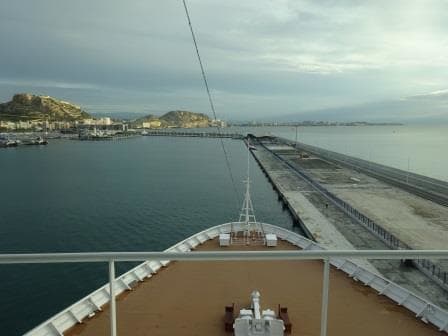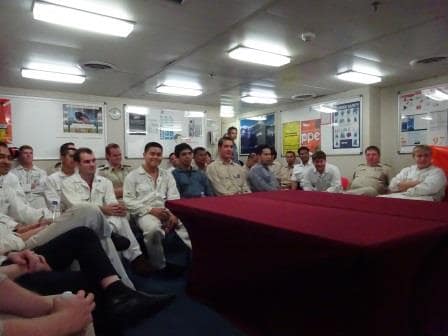Alicante is typical of the south Spanish ports. A large breakwater / pier which runs parallel along the coast. The inner side of this breakwater was normally used for ships making short stops and with the increase in the cruise Industry that is where the cruise ships are docking as they normally stay for shorter periods than the cargo ships. Several of these piers have now been adapted especially by building cruise terminals on top of it. Today we docked at one of those piers here in Alicante and it will be the same in Malaga tomorrow. (It was the same in Barcelona, only Palma de Mallorca was different) It makes arrivals and departures fairly easy as docking the ship is a matter of slowing down and then going sideways to the dock. In several ports you can even leave by just backing out, something the Rotterdam did when it called at Malaga recently. (See my specific blog in the archives)

The cruise terminal is half way along the breakwater. If we had docked at the end, it would have doubled the distance.
Today we thus also parked at the inside of the breakwater and although that was easy for the ship, it meant that it was a long way from the city, made even longer as we were at the Cruise Terminal near the end of this long breakwater. But with plenty coaches around everybody who wanted to go, could get to the town. There were however quite of few guests who decided to stay on board today to catch their breath and to build up stamina for Malaga tomorrow. As it was nice weather, sitting on the outside deck and lazing the day away is also part of cruising. Plus often there is the added bonus of seeing the sailors working on the outside decks and there are few things nicer than watching other people work. (Plus it gives a good feeling to know that your cruise fare helps them to make a living)
As mentioned yesterday, today we had our weekly Fire drill and the focus was this time on the Engine Room and what to do when the normal fire fighting procedures do not work. That means we have to go to the final resort or releasing CO2. The problem with cO2 is, that although it is a good extinguishing agent, it works the best when the temperatures in the Engine Room have not yet reached a too high a value. The longer the fire rages, the more damage and the greater the chance of Reflash due to the longer natural cooling down period. Co2 does not have as much of a temperature reducing capability such as water has. Thus the rule of thumb is that the Master has to make up his mind within 10 minutes after the fire has occurred and the CO2 should be released within the next 5 minutes to be the most effective.
That means the necessary procedures to establish if we need to release CO2, if all crew is out, and if the ER is completely closed and locked down has to be done in that short period of time. CO2 works by replacing Oxygen and is thus fatal for crew still in the area concerned and also very dangerous if it would leak out of the area concerned. And for that you really need to train well. Coordination between the Chief Engineer who assesses the situation, the Master who makes the final decision and the Officers in the CO2 room who release the agent, have to be seamless to ensure it goes fast, achieves the objective and there are no casualties. For the older cruise ships it means losing all propulsion power and most of the power for the ship as well. (Only the Emergency Generator is left) for newer cruise ships which include the Zuiderdam it has less of an impact as the ship has two separate engine rooms. The idea being is, if one is out of order than the other one still works and takes over.

These are the officers and crew who man the fire teams. You have to be young and strong to be able to carry the heavy gear and fight a fire at the same time.
An important part of the drill sequence is the debriefing afterwards. Doing a nice drill is good fun but the objective is to learn from every drill. That is why I act during these drills as Assessor. Going around and observing. Checking if the policies are being followed, issue compliments where things went well and note the items which could have gone better. Those are discussed and then kept on file to be incorporated as objectives in the scenario for the next drill. In this way we create a continuous learning and improvement process which increases the proficiency of all the crew involved. Normally the debriefing takes as long as the whole drill, as each participant is given the chance to speak up and help with the debriefing process.
Tomorrow we are in Malaga and the weather will be less good than today. On departure today we already saw dark clouds gathering at the horizon and there are rain clouds coming over the southern part of Spain. According to the weather forecast there is supposed to be very little wind in those clouds and thus all should be well for arriving on time.

October 26, 2015 at 4:51 pm
Dear Captain Albert,
With great interest I read your blog about firefighting drills and the use of the the heavy Personal Protective Equipment (PPE) the fighters have to carry, apart from the handling of the firefighting equipment. At the moment there is discussion about operations in enclosed spaces and the use of the heavy PPE that can even hamper the job to be done. Especially when a casualty has to be rescued and recovered. (see Seaways, International Journal of the Nautical Institute; October 2015)
My question is: is there some kind of smaller and lightweight adequate equipment available for these rescue operations in enclosed spaces to provide the person to be rescued with oxigen?
Regards,
Elbert L.J.
October 27, 2015 at 1:33 pm
Yes, there is.
Drager (who makes most of the scuba gear that we use) has little bottle packs which give 5 minutes of air. Our ships carry a minimum of two of them and they are on standby in case we have to do a confined space rescue. They are not much larger than a childeren’s back pack and can be worn on the back, or on the breast. They strap on easily, so one can be fitted quickly on the face of the person needing rescue. Great invention and a big improvement over having to shove a SCUBA pack ahead of you through a tank.
Best regards
Capt. Albert
October 26, 2015 at 6:09 pm
I was on a T2 tanker where a leak nearly filled our engine room bilges with a light product that caught fire. We exhausted all of our portable extinguishers then pulled the main CO2, which was not effective. Eventually we finally put out the fire with steam hoses.
October 27, 2015 at 1:28 pm
Good morning,
steam smothering has the same effect as Co2, but is not allowed anymore due to the danger of steam explosions caused by overheated steam.
Best regards
Capt. Albert
October 27, 2015 at 4:17 am
Capt. Albert,
Thank you so much for taking the time to write your daily blog. It’s very interesting to get a glimpse “behind the scene”.
One question about taking command as Master of a new ship: As ships have different handling characteristics, how does a Captain go about to learn the “behaviour” of his new ship? How much introduction/training is typically needed to safely manoeuvre the vessel?
Thanks in advance.
October 27, 2015 at 1:25 pm
Thank you for reading my blog.
We all go to simulators were we learn the basic handling of each ships type and get the feeling of how a ship handles. then we go on board and if it is an existing ship we work for 14 days with the leaving captain to learn the tricks and oddities for that particular type of ship. In our company there is a difference between the S class (becker rudders) the R class (Spade rudders) and the Vista & Signature class (no rudders but azipods) Although the basic handling is the same it takes a little while before you are comfortable with all the details. Same as with a car, a clutch and an automatic, drive the same, but you need a little bit of playing to get comfortable when going from one system to another.
I hope this helps
Captain Albert